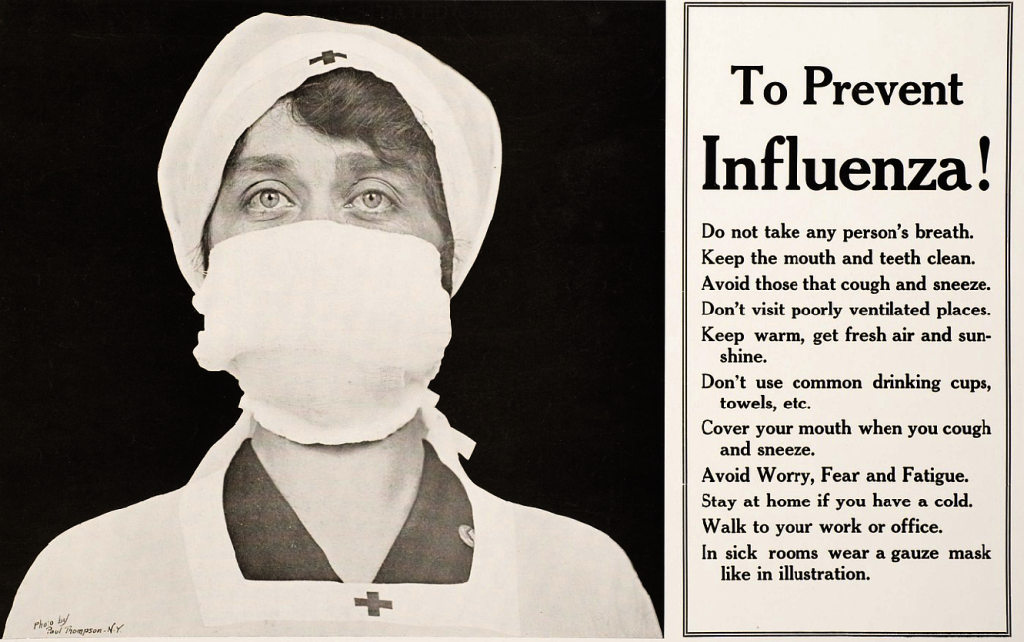|
Early in March
1918 a highly contagious strain of flu appeared at a
large army camp in Kansas, USA. By the end of the month of the
troops stationed there 1,100 had been hospitalised of which 38 died
after developing bronchial pneumonia, a hallmark of the disease.
As U.S. troops joined the war effort they brought the virus with
them which spread quickly throughout Western Europe and beyond.
However, despite its high contagion this strain of the virus wasn’t
particularly dangerous. Its symptoms generally passed after
several days, and mortality rates were similar to those of seasonal
flu.
It was at this time that the disease was named “Spanish Flu”, a
misnomer that stemmed from wartime censorship. In the
interests of maintaining public morale, the press was initially
prevented from reporting the flu outbreak that was spreading through
the armed forces. Spain, on the other hand, was neutral.
It didn’t impose wartime censorship and so it appeared from Spanish
news reports that the flu epidemic was confined to that country,
hence its name.
During the summer of 1918 cases of Spanish flu diminished leading to
the belief that the virus had run its course — it had not.
Somewhere in Europe a mutated strain of the virus emerged that had
the power to kill a perfectly healthy young man or woman within 24
hours of showing the first signs of infection:
“THE
EPIDEMIC. ― There is genuine alarm on every hand in London at the
remarkable spread of the so-called ‘influenza epidemic.’ One
hears the most extraordinary stories of people suddenly stricken
down — some in the open streets — with this mysterious malady, and
many dying within a few hours of their seizure. Doubtless some
of these stories are exaggerated, but there is no gainsaying the
fact that the disease, whatever it is, is still rampant. It
would appear that there are not enough doctors to cope with the
extraordinary demands which are being made upon them, and in the
peculiar circumstances the Minister of National Service has
certainly done the right thing in issuing an official notice
cancelling all calling-up notices for medical examination of
recruits, thus freeing a large number of medical men for service
among the general public.”
Bucks Herald, 2nd
November 1918
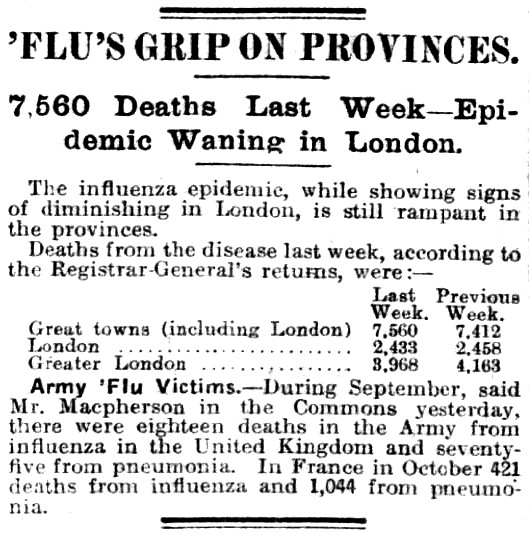
Daily Mirror, 14th
November 1918
The second wave of the global pandemic had begun. What surprised the
medical authorities was not the high mortality among the very young
and old, but the high mortality rate among those in their prime of life:
AYLESBURY:
HEALTH OF THE DISTRICT.—The Medical Officer’s quarterly report
showed that there had been 53 births and 215 deaths, 104 of which
were non-native, thus reducing the actual mortality for the district
to 111. Deaths from influenza alone numbered 80. Having
observed every epidemic of influenza since 1889, he was much
impressed by the liability of the present influenza to attack
children and young adults. During the quarter there had been
several hundreds of cases, and only one of those was over 50 years
of age; in fact, most of them had been well under 40 years of age.
In the 1889 epidemic old age was the factor which determined life or
death in the broncho-pneumonia complications, but in the recent
epidemic the reverse was the case.
Bucks Herald,
18th January 1919
In young, healthy adults, this virulent strain of flu virus triggered an immune
overreaction that led to severe inflammation and a fatal build-up of
fluid in the lungs, causing sufferers to drown in their own body
fluid. This was in an age in which there was no influenza vaccine [1]
nor were antibiotics available to treat pneumonia. [2] The
only treatment available was a combination of fresh air, sunlight,
scrupulous standards of hygiene, and reusable face masks; there is evidence
that this did reduce
deaths among some patients and the spread of infections among
medical staff. There were, of course, plenty of advertisements
for preparations, which, like the “carbolic smoke ball” of an
earlier age, [3]
were of highly doubtful efficacy in combating influenza:
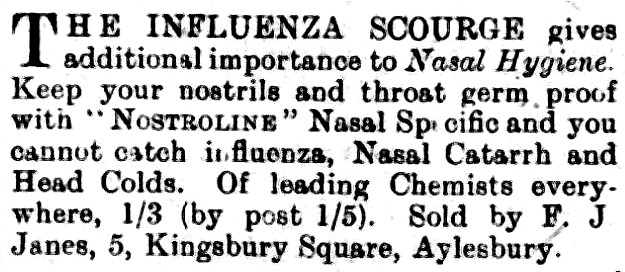
Advertisements
from the Bucks Herald,
11th January (above) and 15th February (below), 1919.
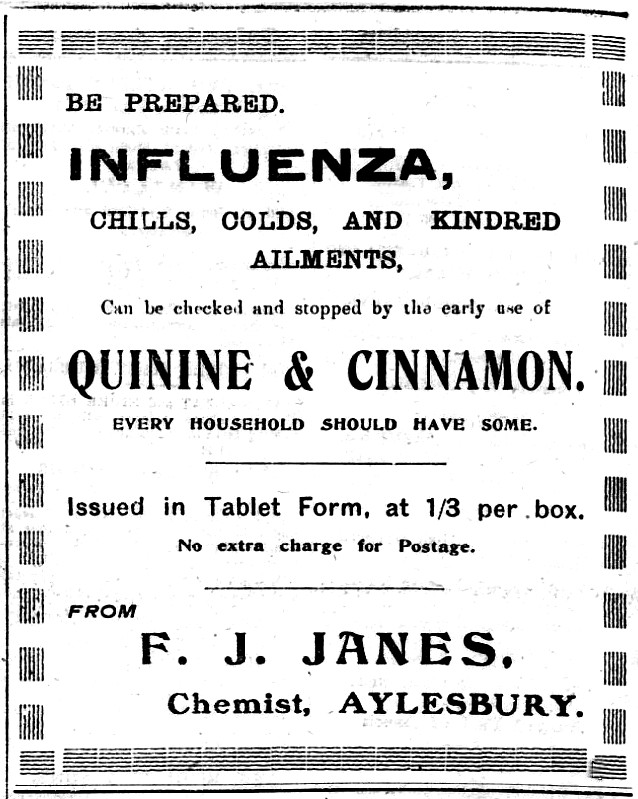
By this time censorship could no longer keep the lid on the pot and
news reports began to appear, although compared with the national
press and that covering the Eastern side of the county, Tring’s
paper, the Bucks
Herald, has
surprisingly little to say on the subject. The following
represent some of its reports:
TRING: ROLL OF
HONOUR
It is our
sad duty this week to chronicle the death of the only son of Mr. and
Mrs. Henry Fenner, of Pendley Lodge, who died in Bramshott Hospital
on October 12 from pneumonia following an attack of influenza.
Lawrence Henry Fenner, who was 29 years of age, emigrated to Canada
some ten years ago. Early in 1916 he joined the Saskatchewan
Regiment, and after training proceeded to France, where in the great
battle of Paschendale in November last he was badly gassed. He
was sent home to England, where for a long time he suffered from the
effects of the gas.
Being attached to the Bramshott Depot for orderly room duties, he
there earned the highest esteem of all, both officers and men.
Seized with illness he was taken to hospital, and passed away on
Saturday, his father and mother being with him.
19th October 1918
DEATH OF ALFRED CLARENCE SAUNDERS.
. . . . eldest
son of Mr. and Mrs. A. T. Saunders, of [Tring]
High-street, after a very short illness . . . . Quite early in
October Mr. Saunders had an attack of influenza, and pneumonia
supervening he passed away . . . . Deceased was an architect, and
held an important position in the well-known firm of Robinson and
Roods . . . . having previously trained with Mr. Wm. Huckvale [Architect]
of Tring.
26th October 1918
TRING: INFLUENZA EPIDEMIC.
There are a number of cases in the town, and the medical men are
kept remarkably busy. Fortunately, there have not been many serious
cases, and recovery is generally made with good nursing. A portion
of the elementary schools, which were recently in the occupation of
the military authorities as a hospital, have again been fitted up by
local residents for the purpose of nursing influenza patients. The
schools in the town have been closed during the past week, owing
chiefly to illness amongst the teaching staff.
2nd November 1918
WIGGINTON: THE WAR TOLL.
We regret to have
to record the death of another Wigginton man, Pte. Arthur Kingham (The Buffs), youngest son of Mr. Fred Kingham. Previous to
being called up he worked for Mr. George Rowe, builder, etc. After
training he was drafted to France, and had only been there a short
time when he was attacked by influenza followed by bronchial
pneumonia and died Oct. 19.
2nd November 1918
TRING: PRIVATE JAMES EDWARD AYRES
James Edward Ayres, of Akeman-street, who is well known in the
district, having for many years acted as porter at local auction
sales, and waiter at many public functions, and also newsagent for
Sunday papers, joined the army less than a month ago. On
Wednesday last week his wife was sent for to Woolwich, where Ayres
was in hospital with influenza which was followed by pneumonia, and
soon after her arrival he passed away. The deepest sympathy is
extended to the wife and daughter in their bereavement.
2nd November 1918
WIGGINTON: THE INFLUENZA.
There are so many cases of the prevailing epidemic in the village
that the Day and Sunday Schools have been closed by the medical
authorities. It was the cause of death on Thursday, Oct. 31, of Mr.
W. Gurney. He leaves a widow and ten children, five of whom are
under fourteen. Much sympathy is felt for the family.
9th November 1918
CHESHAM: INFLUENZA.
The number of deaths of young people from influenza in this locality
is alarming, and week by week there is a heavy obituary list. It is
noticeable that many of the deceased were particularly strong young
people.
7th December 1918
TRING:
PRIVATE ARTHUR FRANK WELLS.
Frank Wells of Albert Street, was carried off after an
attack of influenza somewhat suddenly at a hospital in France . . .
. He was 41 years of age, and before joining the Army Ordnance Corps
some three years ago was a tailor in business for himself. He leaves
a widow and three children . . . . he was buried in Blargies
Cemetery on the day following his decease.
1st March 1919
FARR:
IN MEMORIAM.
In ever-loving memory of my dear little DAVID, who died of
chronic bronchial pneumonia, following influenza and measles, on
July 10th, 1919, aged 2 years and 8 months.
In my thoughts day and night,
darling, as long as life lasts.
C.F.
10th July 1919
TRING: EX-OFFICER’S
SAD DEATH
Mr. Albert T. Grace, who
after a long and painful illness contracted on active service,
passed away at Kennington Hospital for Officers . . . . He took part
in the heavy fighting of the opening phases of the German offensive
in 1918 around Kemmel and Ypres . . . . With his health undermined
by his service in the East . . . . he was invalided to England . . .
. He appeared to be making good progress and hopes were entertained
for his recovery, but influenza and pneumonia supervened, and his
death resulted before any of his relatives could be summoned.
31st January 1920
In the early 1970s, British historian Richard Collier placed adverts
in newspapers around the world asking for memories of the 1918
Spanish influenza pandemic. He received over 1,700 replies, which he used
to provide material for his book The Plague of the Spanish Lady (Macmillan, 1974). Elsie
Phillips Cole writing from Tring had this to say of her experience:
“My husband was in France ... I had 3 children under 4 years, boys.
I remember one night in particular, I slept between the cots of my
two eldest and we all had high temperatures from flu – but I was
nursing my baby just the same – there was no time to wean him. The
boys were restless and tossed and muttered – but the baby slept on,
unusually, till I was dressed and when I took him from his cot he was
practically unconscious and limp.
“I had read in The Daily Mail that the French treated the flu
successfully by taking nothing but brandy for 3 days. By the
grace of God I had about 1oz. of brandy left and I began to wet the baby’s
lips with it and got a little down him till he became fully
conscious. I looked out of the window for help and saw the empty car
of the one doctor left in Tring. I raced downstairs and got in the car
till he came out of his client’s house and got him to see my baby
and in no time he had the very efficient District Nurse in to help
me. My daily help had not been able to come, as her brother was on
leave from France and he was down with the flu and my sister and
parents, who lived near also and their staff had it.
“There were
isolated Cottages where all the inhabitants lay dead and unattended
(3 to be exact close to Tring) and the National School was turned
into a Hospital, but with 3 trained Nurses in charge. But the 3
nurses caught it, 1 died and 2 ended up in a mental home. My aunt
volunteered but gave up when she had it.”
A third and dangerous wave of Spanish Flu emerged in 1919, and with infection being
spread by troops returning home the mortality rate was as high as
in the second wave.
The end of the war eventually removed the crowded
munitions factories and the cramped and insanitary living conditions
of the troops that had combined to allow the disease to spread so far and so
quickly. It is now believed that no other pandemic in history
killed so many in such a short time as Spanish Flu. [4]
In view of its high mortality, sad to say there is no public memorial in the UK to the victims of the Spanish
Flu pandemic and to the medics and others that strove to help them, but this reflects international practice with
New Zealand
providing one exception.
By 1920 the Spanish Flu virus had become much less deadly with its
effect eventually diminishing to that of ordinary seasonal flu.
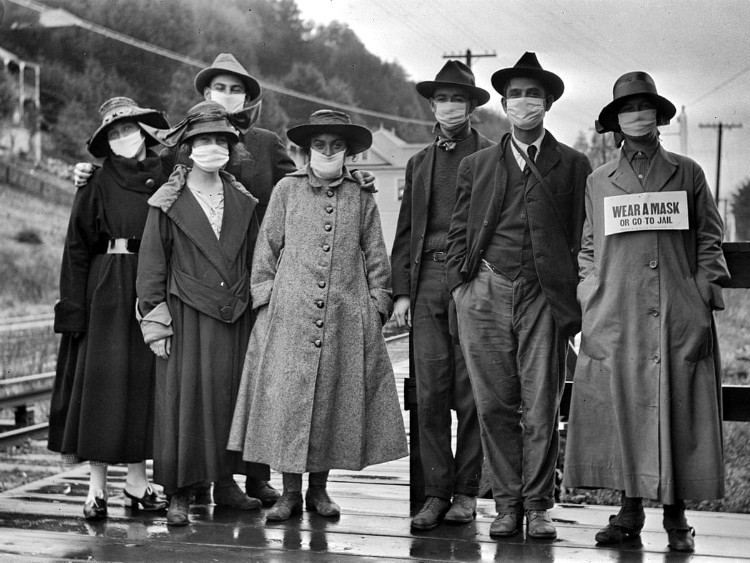
Ian Petticrew
January 2022
――――♦――――
Footnotes
1. Viruses were demonstrated to be particles, rather than a fluid,
by Wendell Meredith Stanley, and the invention of the electron
microscope in 1931 first allowed their complex structures to be
studied. During the Second World War the US military developed
the first approved inactivated influenza vaccines (these vaccine
used fertilised chicken eggs, a method that is still used to produce
most flu vaccines). At the same time mechanical ventilators
became available, which allowed the breathing of patients suffering
respiratory complications to be supported.
2. M&B 693 was one of the early generation of sulphonamide
antibiotics (aka sulpha drugs). Originally produced by the British
firm May & Baker Ltd in 1938, it was the first chemical cure for
pneumonia. Penicillin did not become available for civilian use in
the UK until 1946.
3. The Carbolic Smoke Ball Company made a product called the
“smoke
ball”
filled with carbolic acid, which, it claimed, was a cure for
influenza and a number of other diseases. This bogus claim
resulted in the leading case in English contract law of
Carlill v
the Carbolic Smoke Ball Company (1893, 1 QB 256 Court of Appeal).
4. It is estimated that about 500 million people or one-third
of the world’s population became infected with this virus. The
number of deaths was estimated to be at least 50 million worldwide
with about 675,000 occurring in the United States.
Centre for
Disease Control and Prevention |


